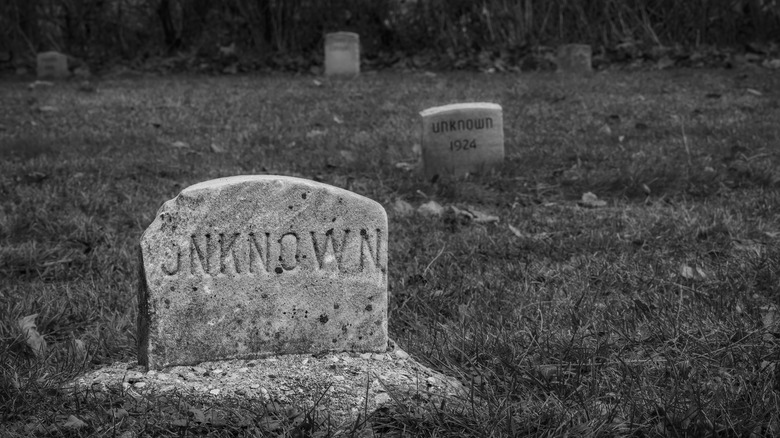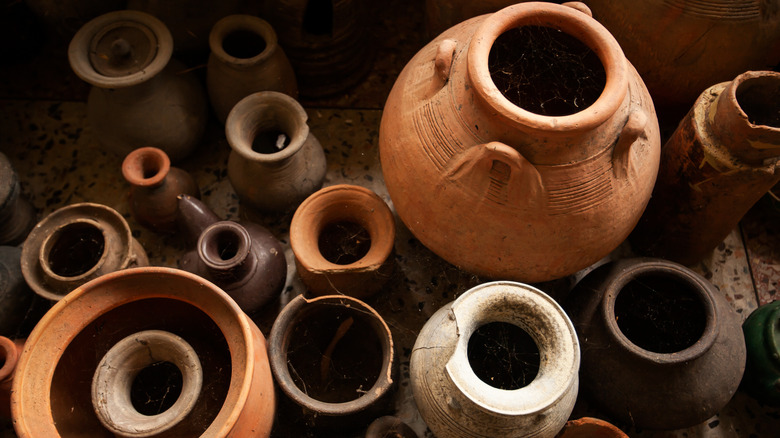Why Graves Of The Unknown And Poor Are Called Potter's Fields
Few things could be sadder than an unmarked, unnamed grave. Yes, we have memorials for the bodies of unidentified soldiers fallen in combat, like the Tomb of the Unknown Soldier at Arlington National Cemetery in Arlington, Virginia. Yes, crime victims sometimes go unidentified, and receive a John Doe or Jane Doe moniker from authorities like the FBI. And yes, some of society's most marginalized, particularly the poor and homeless, might die unnoticed and remain unrecognized in death. But thankfully, there's usually at least one person alive who will know the deceased. That deceased person, whether buried or cremated, can receive a personalized headstone and be remembered by name — at least until erosion takes hold.
But what do we do for the unnamed, unknown dead? Every country in the world has different customs, especially when factoring in religious beliefs. In the U.S., burial laws usually fall to state jurisdiction, as the Law Offices of Stimmel, Stimmel, & Roeser explains. Funeral Guide says that "paupers' funerals" — funerals for unclaimed bodies, or for individuals whose relatives are unable to pay — happen by the thousands every year in the U.K. and are regulated by local councils. Unclaimed and unknown dead are buried without headstones in a "common grave" owned by no one. Such land has been historically referred to as a "potter's field," a term that comes from the Bible and took on widespread use in the 17th century.
Worth 30 pieces of silver
The book of Matthew, chapter 27, from the Bible's New Testament contains the first historical reference to a "potter's field." Verses one through ten continue a story very familiar to Christians, when Jesus' disciple Judas Iscariot betrayed his master to Roman authorities for 30 pieces of silver. After receiving his pay and learning that Jesus had been sentenced to death, Judas is wracked by grief and hangs himself. Before he does so he chucks his silver into a temple. Some priests find the money, but not Judas' body, and say that they can't keep the money because it's "blood money." So, they decide to use it to buy some land as "a burial place for foreigners." Specifically, they buy "the potter's field." Although it's not clear which local potter they're talking about, it does seem like we're talking about a literal field owned by a person who makes pots.
But why a potter's field? And is a potter's field just a field owned by a potter? Grammarist suggests that the potter's field wasn't used to grow crops but to dig for clay used to make pots. If so, the soil would have likely been stripped, not good for growing things, and as Mental Floss points out, full of holes from digging. It's possible that all such factors might have made the land ideal for burials. But, this is all speculation, as there's no way to verify any of it one way or another.
Burial land for the poor
There's no clear path from the potter's field mentioned in the Bible — the one bought with Judas Iscariot's 30 pieces of silver — to the modern definition of a potter's field. There is, however, a confluence of factors that gave rise to the modern meaning, including the Biblical potter's field being a burial place for "foreigners," as Matthew, chapter 27 says. How Stuff Works says that folks of the same community throughout medieval Europe were often buried together. Travelers, foreigners, and other non-locals who died got consigned to the outskirts of a burial ground. Wondrium Daily tells us that ancient Rome also used mass graves called puticuli (literally meaning "to rot or decompose") for its poorest people, i.e., those without a marked grave.
Come 1611 C.E., per Mental Floss, the King James version of the Bible saw the first appearance of the term "potter's field" in modern English. This happened right around the time that folks had already started using the word "potter" as slang, meaning someone who potted around, i.e., a vagrant, vagabond, wastrel, etc. This also happened, as How Stuff Works says, right around when the Dutch in New Amsterdam (later called New York) started building modern cemeteries — the kind we're used to with individual headstones arrayed in rows. And so it was, when all these factors came together, that a "potter's field" became a description of the land used to bury the unknown and poor.


